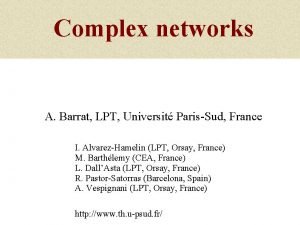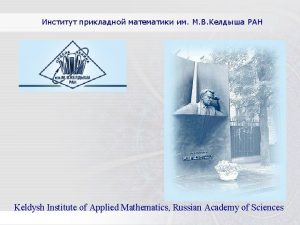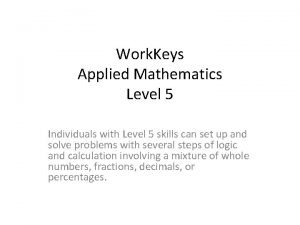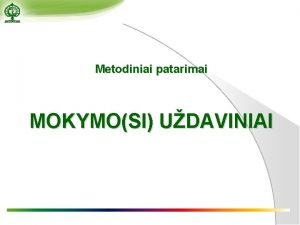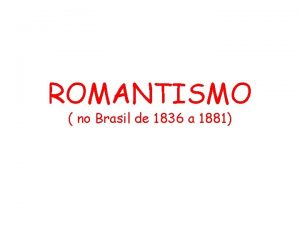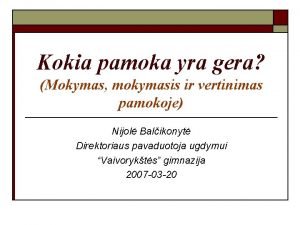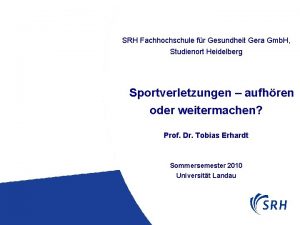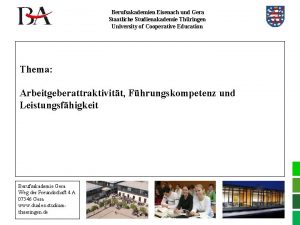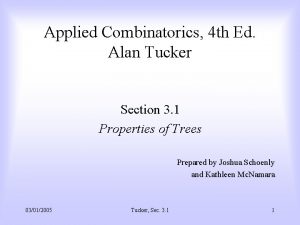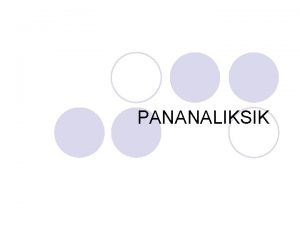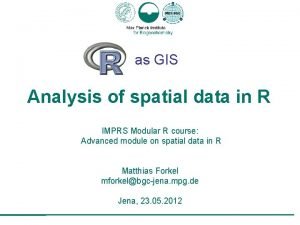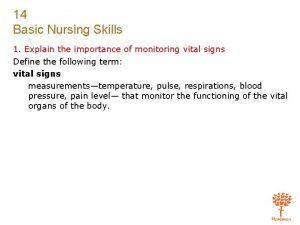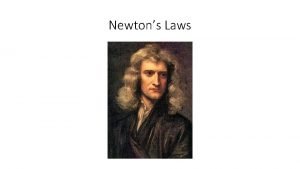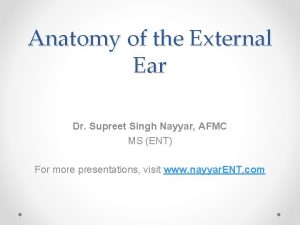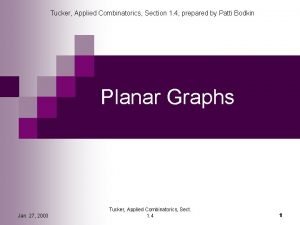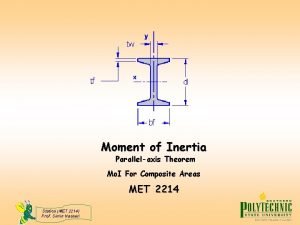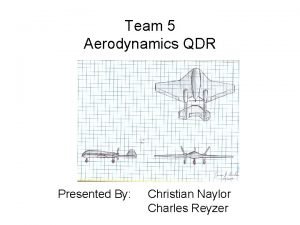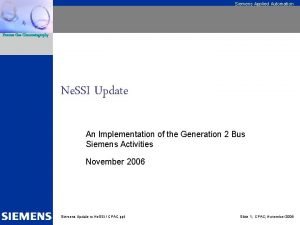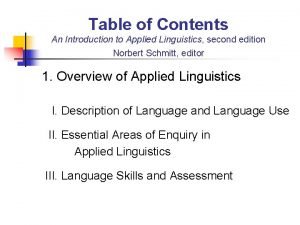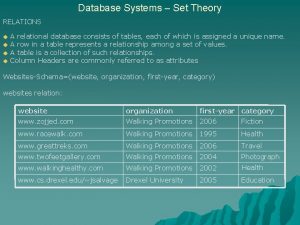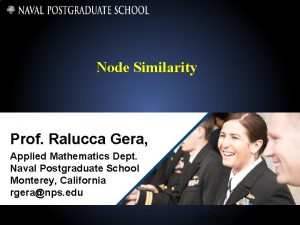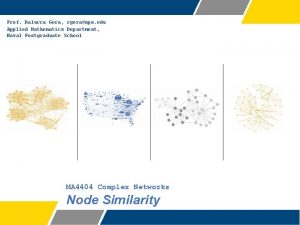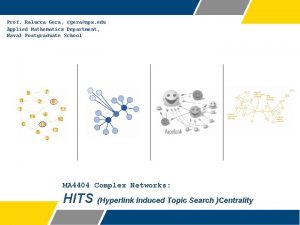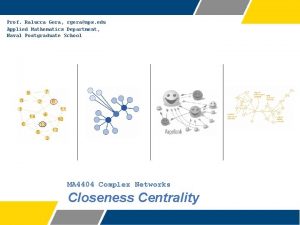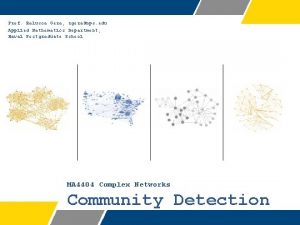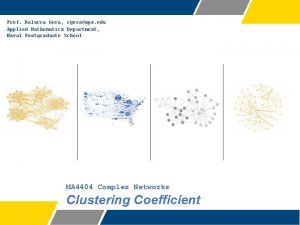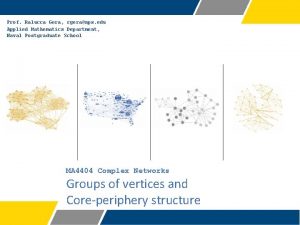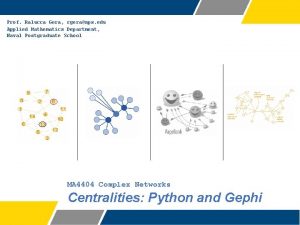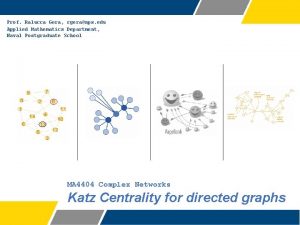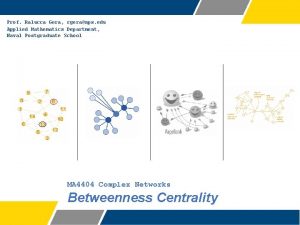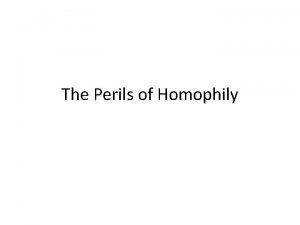Homophily or Assortativity Prof Ralucca Gera Applied Mathematics













































- Slides: 45

Homophily (or Assortativity) Prof. Ralucca Gera, Applied Mathematics Dept. Naval Postgraduate School Monterey, California rgera@nps. edu Excellence Through Knowledge

Learning Outcomes ü Understand how to measure that nodes with similar characteristics tend to cluster, • Based on enumerative characteristics (nationality) • Based on scalar characteristics (age, grade) • Based on degree. ü Analyze network using hommophily by identifying the assortativity values based on various caracteristics. ü Evaluate: consider why behind the what is the assortativity values of your network. 2

Are hubs adjacent to hubs? • Real networks usually show a non-zero degree correlation (defined later compared to random). – If it has a positive degree correlation, the network has assortatively mixed degrees (assort. based other attributes can also be considered). – If it is negative, it is disassortative. • According to Newman, social networks tend to be assortatively mixed, while other kinds of networks are generally disassortatively mixed. 3

Homophily or assortativity Sociologists have observed network partitioning based on the following characteristics: – Friendships, acquaintances, business relationships – Relationships based on certain characteristics: • • • Age Nationality Language Education Income level Homophily is the tendency of individuals to choose friends with similar characteristic. “Like links with like. ”

Homophily or assortativity is a common property of social networks (but not necessary): – Papers in citation networks tend to cite papers in the same field – Websites tend to point to websites in the same language – Political views – Race – Obesity 5

Example of homophily 6 http: //www. slideshare. net/Nicola. Barbieri/homophily-and-influence-in-social-networks

Assortativity by race 7 James Moody

Assortativity by political views Titter data: political retweet network Red = Republicans Blue = Democrats Note that they mostly tweet and re-tweet to each other 8 Conover et at. , 2011

Disassortative • Disassortative mixing: “like links with dislike”. • Dissasortative networks are the ones in which adjacent nodes tend to be dissimilar: – Dating network (females/males) – Food web (predator/prey) – Economic networks (producers/consumers) 9

Why? Excellence Through Knowledge

Why? • Identifying people of interest could be easy if the network presents homophily • When assortivity (homophily) is low lie Pokec, Red. Learn. RS (machine learning algorithm that depends on the count of POIs neighbors of nodes) outperforms all other strategies. • When attributes show high homophily, Red. Learn. RS performs quite similar to the other algorithms. 11

How? Excellence Through Knowledge

Gephi: Install Circular Layout The Radial Axis Layout groups nodes and draws the groups in axes : • Group nodes by degree, in degree, out degree, etc. • Group nodes by attribute sort (based on data type of attribute). • Draw axes/spars in ascending or descending order. • Allows top, middle or bottom "knockdown" of axes/spars, along with ability to specify number of spars resulting after knockdown. 13

Homophily in Gephi here 14 https: //gephi. org/users/tutorial-layouts/

An example: ordered by communities 15

Homophily in Python • To check an attribute’s assortativity: assortivity_val=nx. attribute_assortativity_coefficient(G, "color“) The attribute “color” can be replaced by other attributes that your data was tagged with. • If the attribute is “degree” then we obtain degree assortativity: r = nx. degree_assortativity_coefficient(G) • If the attribute is “communities” then we obtain modularity: https: //stackoverflow. com/questions/29897243/graph-modularity -in-python-networkx 16

What? Excellence Through Knowledge

Assortative mixing (homophily) We will study two types of assortative mixing: 1. Based on enumerative characteristics (the characteristics don’t fall in any particular order): 1. 2. 3. 4. Nationality Race Gender Communities 2. Based on scalar characteristics, such as: 1. Age 2. Income 3. By degree: high degree connect to high degree 18

Based on enumerative characteristics (characteristics that don’t fall in any particular order), such as: • Nationality • Race • Gender • Or just communities Excellence Through Knowledge

Possible defn assortativity • 20

Alternative definitions • 21

• Checks if vertices are in the same class Checks for adjacent nodes 22

• Checks if vertices are in the same class 23

• Checks if vertices are in the same class duplications: as you choose vertex j above, the edge ji will be counted after edge ij was counted 24

Consider their difference • Checks if vertices are in the same class 25

Modularity • Checks if vertices are in the same class 26

Enumerative characteristics • 27

Based on scalar characteristics, such as: • Age • Income Excellence Through Knowledge

Scalar characteristics • Scalar characteristics: enumerative characteristics taking numerical values, such as age, income – For example using age: two people are similar if: • they are born the same day or • within a year or within x years, • They are in the same class • Same generation different granularity based on the data and questions asked. • If people are friends with others of the same age, we consider the network assortatively mixed by age (or stratified by age) 29

Assortativity by grade/age James Moody 30

Scalar characteristics • When we consider scalar characteristics we basically have an approximate notion of similarity between adjacent vertices (i. e. how far/close the values are) – There is no approximate similarity that can be measured this way when we talk about enumerative characteristics; rather present/absent 31

Assortativity matrix based on Scalar characteristics Friendships at the same US high school: each dot represents a friendship (an edge from the network) Denser along the y = x line (because of the way data is displayed) Sparser as the difference in grades increases 32

Strongly assortative Data: 1995 US National Survey of Family Growth • Top figure: A scatter plot of 1141 married couples • Bottom figure: The same data showing a histogram of the age difference 33 Newman, Phys Rev E. 67, 026126 (2003)

Scalar characteristics • How do we measure scalar assortative mixing? • Would the idea we use for the enumartive assortative mixing work? • That is to place vertices in bins based on scalar values: – Treat vertices that fall in the same bin (such as age) as “like vertices” or “identical” – Apply modularity metric for enumerative characteristics 34

Scalar characteristics • Similar to the enumerative one again Either 0 or 1 35

Computer Science faculty 88 Computer Science faculty: • vertices are Ph. D granting institutions in North America • Edge (i, j) means that Ph. D student at i, now faculty at j labels are US census regions + Canada 36 Five Lectures on Networks, by Aaron Clauset

By degree: high degree nodes connect to high degree nodes Excellence Through Knowledge

Assortative mixing by degree A special case is when the characteristic of interest is the degree of the node • Commonly used in social networks (the most used one of the scalar characteristics) • More interesting since degree is a topological property of the network (not just a value like age or grade) • This now reduces to Pearson Correlation Coefficient

Assortative mixing by degree • Assortative network by degree core of high degrees and a periphery of low degrees (Figure (a) below) • Disassortative network by degree uniform: low degree adjacent to high degree (Figure (b) and (c) below) (a) (b) (c)

Newman’s book (2003) r = assortativity coefficient Newman, M. E. J. "MEJ Newman, SIAM Rev. 45, 167 (2003). " SIAM Rev. 45 (2003): 167. 40

Examples (published in 2003) Same formula: 41 Newman, Phys. Rev. E. 67 , 0626126 (2003)

Range of the value r for real networks Some statistics about real networks published in 2011 https: //www. semanticscholar. org/paper/The-unreasonable-effectiveness-of-tree-based-theor-Melnik. Hackett/0 ef 76143 b 83257592 c 4155 a 648286 ba 7 a 0 cff 474 42

References • Newman, M. E. J. "MEJ Newman, SIAM Rev. 45, 167 (2003). " SIAM Rev. 45 (2003): 167. • Newman, Mark EJ. "Mixing patterns in networks. " Physical Review E 67. 2 (2003): 026126. 43

Extra slides Excellence Through Knowledge

Simpler reformulation for Corr. Coeff. =. 621 for the network below (strongly assort. ) 45 Ref: Newman, Phys Rev E. 67, 026126 (2003)
 Ralucca gera
Ralucca gera Ralucca gera
Ralucca gera Ralucca gera
Ralucca gera Assortativity
Assortativity Keldysh institute of applied mathematics
Keldysh institute of applied mathematics Workkeys applied mathematics level 5 answers
Workkeys applied mathematics level 5 answers Pamokos uždaviniai
Pamokos uždaviniai Norma gera
Norma gera A impossibilidade de realizar o sonho absoluto do eu gera
A impossibilidade de realizar o sonho absoluto do eu gera Gera pamoka
Gera pamoka Gera noordzij
Gera noordzij Mary_srh
Mary_srh Ic fara gera d'adda
Ic fara gera d'adda Berufsakademie eisenach
Berufsakademie eisenach Projeto gentileza gera gentileza ensino médio
Projeto gentileza gera gentileza ensino médio Klemens müller gera
Klemens müller gera Alan tucker applied combinatorics
Alan tucker applied combinatorics Applied hydrology
Applied hydrology Kalikasan ng pananaliksik kahulugan
Kalikasan ng pananaliksik kahulugan Importance of applied science
Importance of applied science R for gis
R for gis Applied sensor technologies
Applied sensor technologies Wjec applied science single award
Wjec applied science single award Handout 14-1 thermometer worksheet answers
Handout 14-1 thermometer worksheet answers A rightward force of 302 n is applied
A rightward force of 302 n is applied Basic and applied research
Basic and applied research Cased pipeline crossings
Cased pipeline crossings Pinna vs auricle
Pinna vs auricle Basic vs applied psychology
Basic vs applied psychology Chaos aip
Chaos aip Oulu university of applied sciences
Oulu university of applied sciences Tucker applied combinatorics
Tucker applied combinatorics Applied software project management
Applied software project management Moment of inertia addition
Moment of inertia addition Applied
Applied Uiuc applied aerodynamics group
Uiuc applied aerodynamics group Applied software project management pdf
Applied software project management pdf Siemens gas chromatograph
Siemens gas chromatograph Force applied
Force applied Overhead rate
Overhead rate Computers & applied sciences complete
Computers & applied sciences complete Linguistic branch
Linguistic branch Pirkanmaan turvallisuusklusteri
Pirkanmaan turvallisuusklusteri An introduction to applied linguistics norbert schmitt
An introduction to applied linguistics norbert schmitt Applied geomorphology notes
Applied geomorphology notes Set theory in database
Set theory in database



